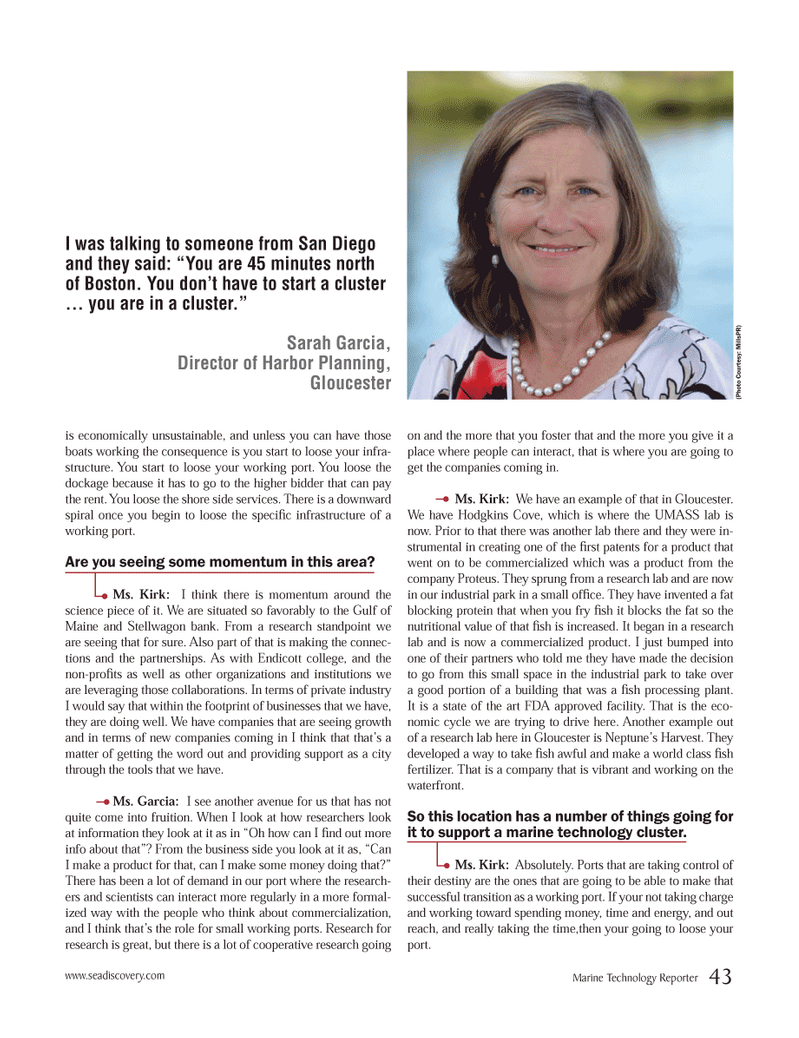
Page 43: of Marine Technology Magazine (October 2012)
Ocean Observation: Gliders, buoys & sub surface monitoring networks
Read this page in Pdf, Flash or Html5 edition of October 2012 Marine Technology Magazine
is economically unsustainable, and unless you can have those boats working the consequence is you start to loose your infra- structure. You start to loose your working port. You loose the dockage because it has to go to the higher bidder that can pay the rent. You loose the shore side services. There is a downward spiral once you begin to loose the speciÞ c infrastructure of a working port. Are you seeing some momentum in this area? Ms. Kirk: I think there is momentum around the science piece of it. We are situated so favorably to the Gulf of Maine and Stellwagon bank. From a research standpoint we are seeing that for sure. Also part of that is making the connec- tions and the partnerships. As with Endicott college, and the non-proÞ ts as well as other organizations and institutions we are leveraging those collaborations. In terms of private industry I would say that within the footprint of businesses that we have, they are doing well. We have companies that are seeing growth and in terms of new companies coming in I think that thatÕs a matter of getting the word out and providing support as a city through the tools that we have. Ms. Garcia: I see another avenue for us that has not quite come into fruition. When I look at how researchers look at information they look at it as in ÒOh how can I Þ nd out more info about thatÓ? From the business side you look at it as, ÒCan I make a product for that, can I make some money doing that?Ó There has been a lot of demand in our port where the research-ers and scientists can interact more regularly in a more formal- ized way with the people who think about commercialization, and I think thatÕs the role for small working ports. Research for research is great, but there is a lot of cooperative research going on and the more that you foster that and the more you give it a place where people can interact, that is where you are going to get the companies coming in. Ms. Kirk: We have an example of that in Gloucester. We have Hodgkins Cove, which is where the UMASS lab is now. Prior to that there was another lab there and they were in- strumental in creating one of the Þ rst patents for a product that went on to be commercialized which was a product from the company Proteus. They sprung from a research lab and are now in our industrial park in a small ofÞ ce. They have invented a fat blocking protein that when you fry Þ sh it blocks the fat so the nutritional value of that Þ sh is increased. It began in a research lab and is now a commercialized product. I just bumped into one of their partners who told me they have made the decision to go from this small space in the industrial park to take over a good portion of a building that was a Þ sh processing plant. It is a state of the art FDA approved facility. That is the eco- nomic cycle we are trying to drive here. Another example out of a research lab here in Gloucester is NeptuneÕs Harvest. They developed a way to take Þ sh awful and make a world class Þ sh fertilizer. That is a company that is vibrant and working on the waterfront. So this location has a number of things going for it to support a marine technology cluster. Ms. Kirk: Absolutely. Ports that are taking control of their destiny are the ones that are going to be able to make that successful transition as a working port. If your not taking charge and working toward spending money, time and energy, and out reach, and really taking the time,then your going to loose your port. I was talking to someone from San Diego and they said: ?You are 45 minutes north of Boston. You don?t have to start a cluster ... you are in a cluster.? Sarah Garcia, Director of Harbor Planning, Gloucester(Photo Courtesy: MillsPR) Marine Technology Reporter 43 www.seadiscovery.com MTR #8 (34-49).indd 43MTR #8 (34-49).indd 4310/3/2012 10:08:13 AM10/3/2012 10:08:13 AM

 42
42

 44
44
